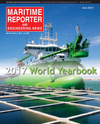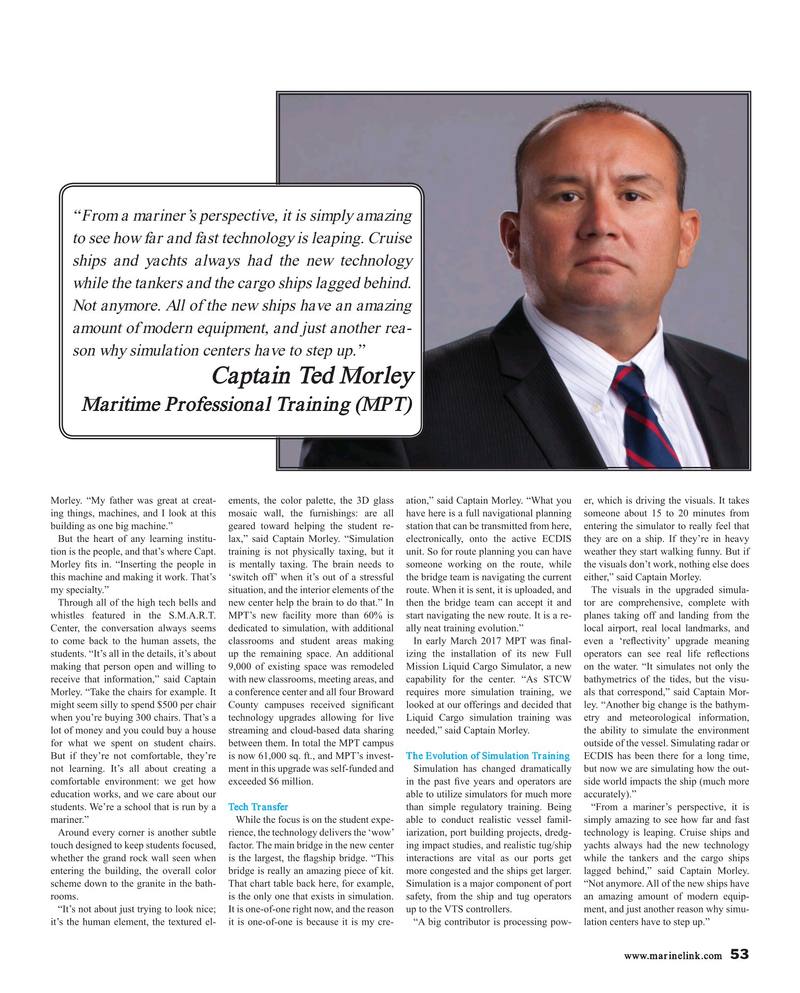
Page 53: of Maritime Reporter Magazine (June 2017)
U.S. Navy Quarterly
Read this page in Pdf, Flash or Html5 edition of June 2017 Maritime Reporter Magazine
“From a mariner’s perspective, it is simply amazing to see how far and fast technology is leaping. Cruise ships and yachts always had the new technology while the tankers and the cargo ships lagged behind.
Not anymore. All of the new ships have an amazing amount of modern equipment, and just another rea- son why simulation centers have to step up.”
Captain Ted Morley
Maritime Professional Training (MPT)
Morley. “My father was great at creat- ements, the color palette, the 3D glass ation,” said Captain Morley. “What you er, which is driving the visuals. It takes ing things, machines, and I look at this mosaic wall, the furnishings: are all have here is a full navigational planning someone about 15 to 20 minutes from building as one big machine.” geared toward helping the student re- station that can be transmitted from here, entering the simulator to really feel that
But the heart of any learning institu- lax,” said Captain Morley. “Simulation electronically, onto the active ECDIS they are on a ship. If they’re in heavy tion is the people, and that’s where Capt. training is not physically taxing, but it unit. So for route planning you can have weather they start walking funny. But if
Morley ? ts in. “Inserting the people in is mentally taxing. The brain needs to someone working on the route, while the visuals don’t work, nothing else does this machine and making it work. That’s ‘switch off’ when it’s out of a stressful the bridge team is navigating the current either,” said Captain Morley. my specialty.” situation, and the interior elements of the route. When it is sent, it is uploaded, and The visuals in the upgraded simula-
Through all of the high tech bells and new center help the brain to do that.” In then the bridge team can accept it and tor are comprehensive, complete with whistles featured in the S.M.A.R.T. MPT’s new facility more than 60% is start navigating the new route. It is a re- planes taking off and landing from the
Center, the conversation always seems dedicated to simulation, with additional ally neat training evolution.” local airport, real local landmarks, and to come back to the human assets, the classrooms and student areas making In early March 2017 MPT was ? nal- even a ‘re? ectivity’ upgrade meaning students. “It’s all in the details, it’s about up the remaining space. An additional izing the installation of its new Full operators can see real life re? ections making that person open and willing to 9,000 of existing space was remodeled Mission Liquid Cargo Simulator, a new on the water. “It simulates not only the receive that information,” said Captain with new classrooms, meeting areas, and capability for the center. “As STCW bathymetrics of the tides, but the visu-
Morley. “Take the chairs for example. It a conference center and all four Broward requires more simulation training, we als that correspond,” said Captain Mor- might seem silly to spend $500 per chair County campuses received signi? cant looked at our offerings and decided that ley. “Another big change is the bathym- when you’re buying 300 chairs. That’s a technology upgrades allowing for live Liquid Cargo simulation training was etry and meteorological information, lot of money and you could buy a house streaming and cloud-based data sharing needed,” said Captain Morley. the ability to simulate the environment for what we spent on student chairs. between them. In total the MPT campus outside of the vessel. Simulating radar or
But if they’re not comfortable, they’re is now 61,000 sq. ft., and MPT’s invest- The Evolution of Simulation Training ECDIS has been there for a long time, not learning. It’s all about creating a ment in this upgrade was self-funded and Simulation has changed dramatically but now we are simulating how the out- comfortable environment: we get how exceeded $6 million. in the past ? ve years and operators are side world impacts the ship (much more education works, and we care about our able to utilize simulators for much more accurately).” students. We’re a school that is run by a Tech Transfer than simple regulatory training. Being “From a mariner’s perspective, it is mariner.” While the focus is on the student expe- able to conduct realistic vessel famil- simply amazing to see how far and fast
Around every corner is another subtle rience, the technology delivers the ‘wow’ iarization, port building projects, dredg- technology is leaping. Cruise ships and touch designed to keep students focused, factor. The main bridge in the new center ing impact studies, and realistic tug/ship yachts always had the new technology whether the grand rock wall seen when is the largest, the ? agship bridge. “This interactions are vital as our ports get while the tankers and the cargo ships entering the building, the overall color bridge is really an amazing piece of kit. more congested and the ships get larger. lagged behind,” said Captain Morley. scheme down to the granite in the bath- That chart table back here, for example, Simulation is a major component of port “Not anymore. All of the new ships have rooms. is the only one that exists in simulation. safety, from the ship and tug operators an amazing amount of modern equip- “It’s not about just trying to look nice; It is one-of-one right now, and the reason up to the VTS controllers. ment, and just another reason why simu- it’s the human element, the textured el- it is one-of-one is because it is my cre- “A big contributor is processing pow- lation centers have to step up.” www.marinelink.com 53
MR #6 (50-57).indd 53 MR #6 (50-57).indd 53 6/8/2017 9:57:56 AM6/8/2017 9:57:56 AM

 52
52

 54
54
